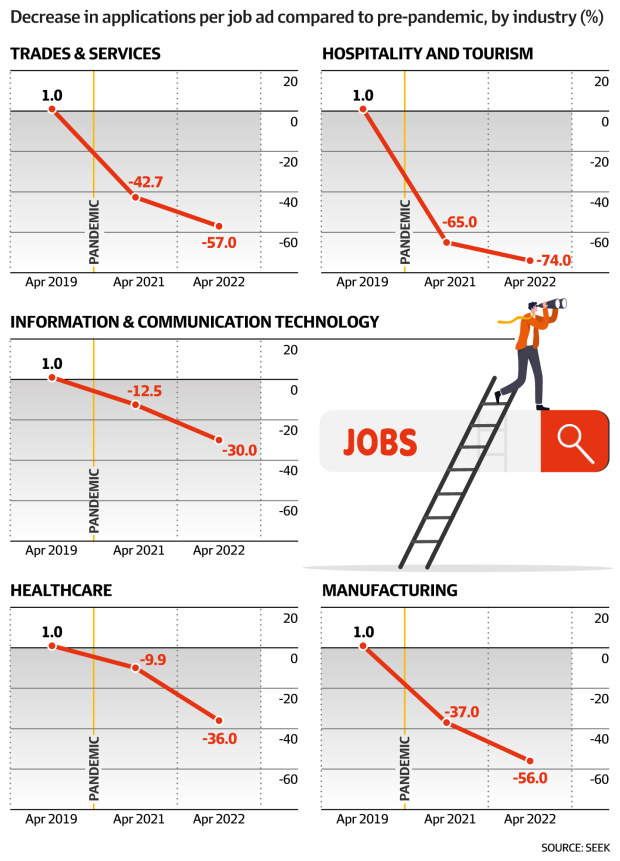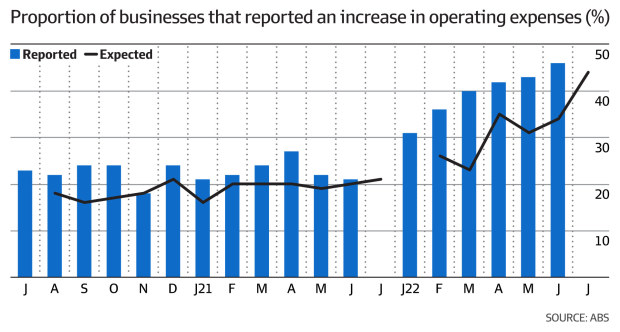- Explainer
- Policy
- Economy
- Employment
Why we don’t have enough workers to fill jobs (in four graphs)
Australian businesses are crying out for more workers with the country in the middle of one of its largest ever labour shortages. There are more than 423,000 job vacancies, according to data from the Australian Bureau of Statistics.
While there is high demand for workers, businesses are struggling to fill those vacancies. Australia’s unemployment rate sits at 3.9 per cent, a 48-year low, and the proportion of the adult population holding a job or actively looking for work has hit a record high 66.7 per cent.

Janie Barrett
How bad is Australia’s skills shortage?
The low supply of available workers has translated to almost a third (31 per cent) of businesses struggling to find suitable workers, ABS data released on Thursday indicates.
Most of these businesses attributed their struggles to applicants not having the required skills (59 per cent) and a lack of applicants (79 per cent).
The inability to find workers is also not sector-specific, with the shortage affecting every industry.

NAB chief economist Alan Oster says the widespread difficulty in finding suitable labour indicates the hundreds of thousands of job vacancies is just as much a labour shortage problem as it is a skills one.
NAB metrics paint an even starker picture, with almost 53 per cent of businesses having difficulty finding suitable labour during the April to June quarter.
“On these measures, it’s as bad as we’ve had it since the early nineties,” Mr Oster told The Australian Financial Review.
He added that the lack of suitable workers has put a brake on production, impacting the resilience of supply chains and the ability for companies to grow.
Which industries are in dire need of workers?
The five sectors that have been hit hardest with staff shortages are trades, hospitality and tourism, healthcare, manufacturing, and technology, according to Seek managing director Kendra Banks.

The staff shortages for these five sectors can be put into two buckets, Ms Banks says.
The first bucket consists of the hospitality and tourism, manufacturing and trades sectors, which are facing labour shortages due to a lack of available workers as a result of the pandemic. These sectors currently do not have their usual supply of international students and holidaymaker visa holders to take on jobs.
“There’s a very significant gap between what our working age population would look like if we hadn’t had COVID and what it does look like today,” Ms Banks says.
“That is impacting every sector and some more than others, particularly retail and hospitality, where international students and working holidaymakers were a significant part of the labor force.”
The second bucket of jobs, primarily in healthcare, technology and specialised trade roles, are vacant as those sectors face a structural shortage of skills.
Mr Oster says it was already difficult to fill these types of jobs before the pandemic, but it had worsened over the past year.
The reasons for the shortages in these sectors are numerous. In healthcare, the recent halt in immigration, a lack of healthcare workers wanting to pursue a career in mental health or nursing, and people leaving the sector due to burnout, have created a structural skills gap.
When it comes to technology jobs, there’s a global shortage of workers with the necessary skills. Markets around the world are vying for workers with these skills, so Australia faces a competitive fight to attract that talent.
What is the solution to our skills shortage?
Mr Oster says the most obvious solution to fixing Australia’s skills shortage is increased migration.
But the means to achieve that migration isn’t so simple.

Australia is still suffering from a full year of international travel restrictions. Net overseas migration – which accounts for people who have arrived in or departed from Australia for longer than 12 months – was a net outflow of 88,800 people for the 2020‑21 financial year. That was the largest number of people leaving Australia since World War One.
Student visa holders contributed the most to this dip, with net overseas migration of international students falling from 18,400 in 2019-20 to negative 61,600 in 2020‑21. Working holidaymakers experienced the next largest decrease, with the number of these visa holders living in Australia decreasing by 6700.
Though comparatively smaller, the number of temporary skilled and other temporary migrants in Australia also fell significantly, with the number of these types of workers in Australia decreasing by 2305.
Australia’s long-term arrivals have almost reached net zero again in the past quarter, but net overseas migration is not expected to reach pre-pandemic levels for at least another 12 to 18 months, Mr Oster says.
To hasten the overseas arrival of much skilled labour, the Albanese government has pushed Home Affairs to expedite approvals for skilled visas.
Since March, more than 58,000 applications for skilled visas, including permanent and temporary skilled places, have been lodged with the department. Nearly 25 per cent of those applications have already been finalised.
Other visas are facing visa processing delays, however. It takes anywhere from 30 days to longer than 15 months to process a SC482 (temporary skills shortage) visa, even if applicants have the required skills and a nomination from an approved business. The slowest 10 per cent of these applications take 15 months to process.
Are companies paying more to attract workers?
With the skills market so tight, attention is now closely focused on whether businesses will pay higher wages to attract staff, both from Australia and overseas. While NAB predicts some pickup in wages is likely, there has been limited signs so far.

But many businesses will find it hard to lift wages, with 46 per cent of businesses experiencing increases in their operating expenses over the previous month, the latest ABS survey found. Reasons include high energy and freight costs as well as a low Aussie dollar making the cost of importing goods more expensive than usual.
Outside of wage increases, Ms Banks says companies have looked at alternative pathways for bolstering staff numbers in the interim by hiring people whose qualifications or experience are not recognised by mainstream recruiting processes.
Some have approached this route by hiring remote overseas workers to fill the gap. Others have hired refugees with technology experience.
“We’ve seen more businesses be more open to overseas remote talent and that can be a way of filling the skills gap in areas like technology,” Ms Banks says.
She says many of these solutions will have limited reach, as the hiring of overseas remote workers is not viable for most health care, specialised trades and engineering roles.
To fix these structural issues and avert a prolonged skills shortage, Ms Banks says Australia needs to expand its targeted migration programs, and invest in both short vocational courses and longer-term skills education and training.
Subscribe to gift this article
Gift 5 articles to anyone you choose each month when you subscribe.
Subscribe nowAlready a subscriber?
Introducing your Newsfeed
Follow the topics, people and companies that matter to you.
Find out moreRead More

Latest In Economy
Fetching latest articles